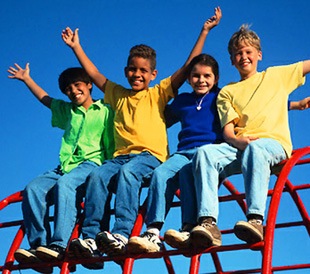 Are kids today becoming sedentary and obese because of a heightened desire for video games, or because their inborn desire to run free in the neighborhood has been squashed by overly fearful parents?
Are kids today becoming sedentary and obese because of a heightened desire for video games, or because their inborn desire to run free in the neighborhood has been squashed by overly fearful parents?
In a National Post opinion column, Marni Soupcoff comments on a Canadian national report card called, Active Healthy Kids Canada.
“Are kids moving enough. Maybe not (though, as a regular observer of nursery school playdates, I can tell you that the little ones I’m seeing would have to defy the laws of both physics and gravity to move any more).
But if inactivity really is a problem, the solution does not lie in “physical activity guidelines for children five and under,” as suggested by the chief scientific officer of Active Healthy Kids Canada.
Nor will more “national commitments to encouraging sport and activity” do the trick, though such commitments will successfully eat up untold quantities of taxpayer money, argues the organization’s CEO.
Motion is kids’ natural state of being.
To get them back there, we don’t need a major nanny-state intervention or experiment in motivational psychology; we just need to remove the impediments. Simply letting kids “off-leash” more often, freeing them up to (literally) run around on their own without constant direct adult supervision would be an excellent start.
“But the fear of crime and predators makes this a frightening proposition for parents. It feels like a dangerous world out there. But, if anything, life is far less risky for little ones today than it was a generation ago when kids were commonly left to their own devices,” posits Soupcuff, who points to safer playgrounds.
Matthew Yglesias writes that in the 1990s, public perception of whether crime was getting better or worse largely tracked reality. But in 2002-2008, Americans began perceiving an increase in crime that did not mirror the reality that crime rates were dropping fast.
In an article called Walking to school, a time-honored tradition, the Salt Lake Tribune tried to return parents’ fears in line with reality. It showcased an elementary school in Salt Lake City that built a network of kids who walk to school.
According to STATS.org, a think tank at George Mason University that monitors the media’s use of statistics, the actual chance of a child being taken by a stranger is about 1 in 1 million. What’s more, David Finkelhor, head of the Crimes Against Children Research Center, which tracks and works to prevent violence against kids, suspects child abductions have actually declined, based on a 26 percent drop in child homicides and a 30 percent decrease in child sex assaults over the last decade.
Despite the fact that walking to school “keeps kids healthy, decreases air pollution and can build confidence in young children through greater self awareness and personal responsibility,” very few parents encourage the practice.
Soupcoff concludes: “Many of the activities that come easiest to kids — exploring, hiding and seeking, playing tag, riding bikes — involve a great deal of physical movement. But they also involve leaving the house and taking risks. The adults in kids’ lives — parents, nannies, teachers — have to be willing to allow such risks before they can expect to see their charges exercising more of their own volition.
What is needed is not another national program or guidelines from on high: “All it takes is a little adult courage.”




















[…] Adult Fears Are Encouraging Obesity in Kids […]
[…] Adult Fears Are Encouraging Obesity in Kids […]